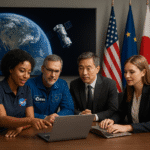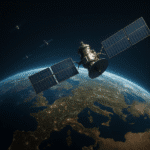The exploration of space has long been a field of international interest and collaboration, with NASA (National Aeronautics and Space Administration) and ESA (European Space Agency) being two of the most prominent organizations in this domain. While both agencies share the common goal of advancing human understanding of space, they differ significantly in their structure, funding, and strategic priorities. This article delves into the key differences between NASA and ESA, as well as the collaborative efforts that have defined their relationship over the years.
Organizational Structure and Funding
One of the most fundamental differences between NASA and ESA lies in their organizational structure and funding mechanisms. NASA, established in 1958, is a United States government agency that operates under the executive branch, specifically reporting to the President of the United States. Its funding is derived from the federal budget, which is approved by Congress. This means that NASA’s budget can fluctuate significantly based on political priorities and economic conditions. In recent years, NASA’s budget has hovered around $20-25 billion annually, making it one of the most well-funded space agencies in the world.
In contrast, ESA is an intergovernmental organization formed in 1975, comprising 22 member states across Europe. Each member state contributes to ESA’s budget based on its GDP, which ensures a more stable and predictable funding stream. ESA’s budget is significantly smaller than NASA’s, typically around €6-7 billion per year. However, the collaborative nature of ESA allows it to pool resources and expertise from across Europe, enabling it to undertake ambitious projects despite its smaller budget.
Strategic Priorities and Missions
NASA and ESA also differ in their strategic priorities and the types of missions they undertake. NASA has historically focused on a broad range of activities, including human spaceflight, planetary exploration, and Earth science. The agency is perhaps best known for its Apollo moon missions, the Space Shuttle program, and its ongoing efforts to send humans to Mars. NASA’s current priorities include the Artemis program, which aims to return humans to the Moon and establish a sustainable presence there, as well as the Mars Sample Return mission.
ESA, on the other hand, has traditionally focused more on robotic exploration and Earth observation. The agency has been a leader in developing satellite technology for monitoring climate change, weather patterns, and natural disasters. ESA’s flagship missions include the Rosetta mission, which successfully landed a probe on a comet, and the Gaia mission, which is mapping the Milky Way in unprecedented detail. While ESA does participate in human spaceflight, it often does so in collaboration with other agencies, such as NASA and Roscosmos.
Collaborative Efforts
Despite their differences, NASA and ESA have a long history of collaboration, recognizing that international cooperation is essential for the advancement of space exploration. One of the most notable examples of this collaboration is the International Space Station (ISS), a joint project involving NASA, ESA, Roscosmos, JAXA, and CSA. The ISS serves as a platform for scientific research and technological development, and it symbolizes the spirit of international cooperation in space.
Another significant collaboration is the James Webb Space Telescope (JWST), a partnership between NASA, ESA, and the Canadian Space Agency (CSA). Scheduled for launch in December 2021, the JWST is set to be the most powerful space telescope ever built, capable of observing the universe’s earliest galaxies and studying the atmospheres of exoplanets. ESA’s contributions to the JWST include the provision of the Ariane 5 launch vehicle and two of the telescope’s four scientific instruments.
Challenges and Future Prospects
While NASA and ESA have achieved remarkable successes through collaboration, they also face challenges that could impact their future relationship. Budget constraints, political pressures, and differing strategic priorities can sometimes hinder joint efforts. Additionally, the rise of new spacefaring nations and private companies is reshaping the landscape of space exploration, introducing new dynamics and opportunities for collaboration.
Looking ahead, both NASA and ESA are likely to continue their collaborative efforts, particularly in areas where their strengths complement each other. For instance, NASA’s expertise in human spaceflight and ESA’s proficiency in robotic exploration and Earth observation could lead to joint missions that leverage the best of both agencies. Furthermore, as the global community increasingly recognizes the importance of addressing climate change, NASA and ESA’s collaboration on Earth science missions is expected to grow.
In conclusion, while NASA and ESA differ in their organizational structure, funding, and strategic priorities, their collaborative efforts have been instrumental in advancing our understanding of space. As the challenges and opportunities of space exploration continue to evolve, the partnership between NASA and ESA will remain a cornerstone of international cooperation in this field.










